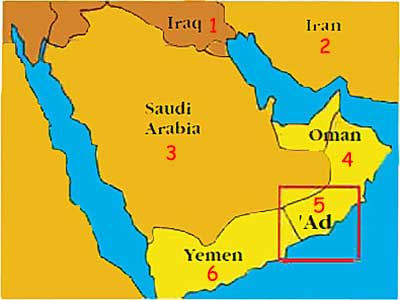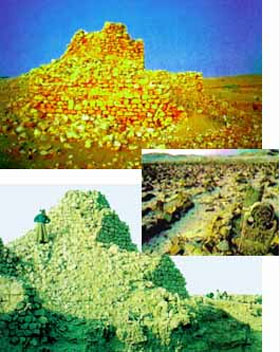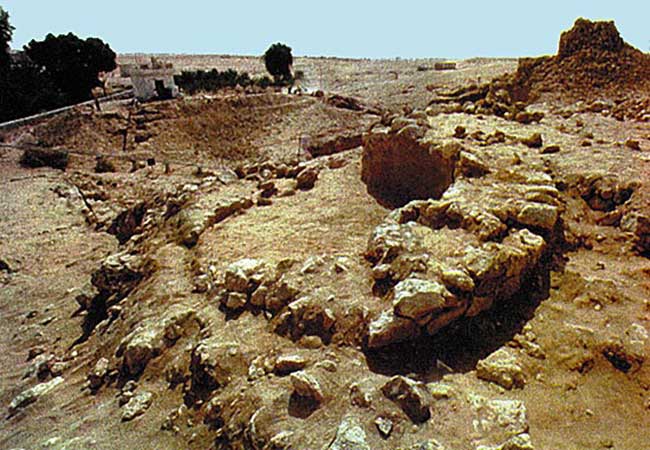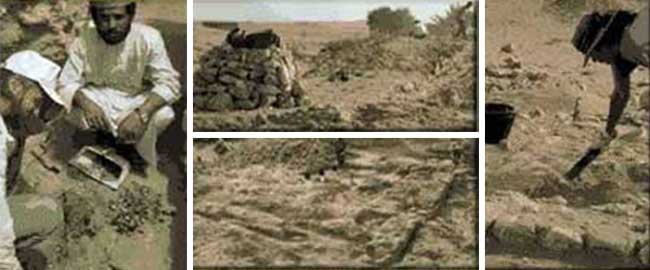The People of 'Ad and Ubar, The Atlantis of the Sands
And the 'Ad, they were destroyed by a furious Wind, exceedingly violent; He made it rage against them seven nights and eight days in succession: so that thou couldst see the (whole) people lying prostrate in its (path), as they had been roots of hollow palm-trees tumbled down! Then seest thou any of them left surviving? (Surat al-Haqqa: 6-8)
Another nation who were destroyed and who are mentioned in various Surahs of the Qur’an is ‘Ad, who are mentioned after the people of Nuh (as). Being sent to ‘Ad, Hud (as) summoned his people, just like all the other prophets had done, to believe in Allah without ascribing partners to Him and to obey him, the prophet of that time. The people reacted to Hud (as) with animosity. They accused him of imprudence, untruthfulness, and attempting to change the system their ancestors had established. In Surah Hud, all that passed between Hud (as) and his people is told in detail:
To the Ad People (We sent) Hud, one of their own brethren. He said:O my people! worship Allah! ye have no other god but Him. (Your other gods) ye do nothing but invent! O my people! I ask of you no reward for this (Message). My reward is from none but Him Who created me: Will ye not then understand? And O my people! Ask forgiveness of your Lord, and turn to Him (in repentance): He will send you the skies pouring abundant rain, and add strength to your strength: so turn ye not back in sin! They said:O Hud! No Clear (Sign) that hast thou brought us, and we are not the ones to desert our gods on thy word! Nor shall we believe in thee! We say nothing but that (perhaps) some of our gods may have seized thee with imbecility. He said:I call Allah to witness, and do ye bear witness, that I am free from the sin of ascribing, to Him, Other gods as partners! so scheme (your worst) against me, all of you, and give me no respite. I put my trust in Allah, My Lord and your Lord! There is not a moving creature, but He hath grasp of its fore-lock. Verily, it is my Lord that is on a straight Path. If ye turn away,- I (at least) have conveyed the Message with which I was sent to you. My Lord will make another people to succeed you, and you will not harm Him in the least. For my Lord hath care and watch over all things.So when Our decree issued, We saved Hud and those who believed with him, by (special) Grace from Ourselves: We saved them from a severe penalty.Such were the Ad People: they rejected the Signs of their Lord and Cherisher; disobeyed His messengers; And followed the command of every powerful, obstinate transgressor.And they were pursued by a Curse in this life - and on the Day of Judgment. Ah! Behold! for the 'Ad rejected their Lord and Cherisher! Ah! Behold! removed (from sight) were 'Ad the people of Hud! (Surah Hud: 50-60)
Another Surah that mentions the nation of ‘Ad is Surat ash-Shu’ara. In this Surah, some characteristics of ‘Ad are emphasised. According to this, ‘Ad were a people whobuild a landmark on every high place, and its membersget for themselves fine buildings in the hope of living therein (for ever). Besides, they did mischief and behaved brutally. When Hud (as) warned his people, they commented that his words werea customary device of the ancients. They were very confident that nothing would happen to them:
The 'Ad (people) rejected the messengers. Behold, their brother Hud said to them:Will ye not fear (Allah)? I am to you a messenger worthy of all trust:
So fear Allah and obey me. No reward do I ask of you for it: my reward is only from the Lord of the Worlds. Do ye build a landmark on every high place to amuse yourselves? And do ye get for yourselves fine buildings in the hope of living therein (for ever)? And when ye exert your strong hand, do ye do it like men of absolute power? Now fear Allah, and obey me. Yea, fear Him Who has bestowed on you freely all that ye know. Freely has He bestowed on you cattle and sons, And Gardens and Springs. Truly I fear for you the Penalty of a Great Day.They said:It is the same to us whether thou admonish us or be not among (our) admonishers! This is no other than a customary device of the ancients, And we are not the ones to receive Pains and Penalties! So they rejected him, and We destroyed them. Verily in this is a Sign: but most of them do not believe. And verily thy Lord is He, the Exalted in Might, Most Merciful. (Surat ash-Shu’ara: 123-140)
The people who showed animosity to Hud (as) and rebelled against Allah, were indeed destroyed. A horrible sandstorm annihilated ‘Ad as if they hadnever existed.
The Archaeological Finds of the City of Iram
The People of 'AD |
 |
| The remains of the city of Ubar, where 'Ad lived, were found somewhere |
At the beginning of 1990, there appeared press-releases in the well-known newspapers of the world declaringFabled Lost Arabian city Found,Arabian city of Legend Found,The Atlantis of the Sands, Ubar. What rendered this archaeological find more intriguing was the fact that this city is also referred to in the Qur’an. Many people who, since then, thought that ‘Ad recounted in the Qur’an were a legend or that their location could never be found, could not conceal their astonishment at this discovery. The discovery of this city, which was only mentioned in oral stories of Bedouins, awoke great interest and curiosity.
It was Nicholas Clapp, an amateur archaeologist, who found this legendary city mentioned in the Qur’an.19 Being an Arabophile and an award-winning documentary film maker, Clapp had come across a very interesting book during his research on Arabian history. This book was Arabia Felix written by the English researcher Bertram Thomas in 1932. Arabia Felix was the Roman designation for the southern part of the Arabian Peninsula which today includes Yemen and much of Oman. The Greeks called this areaEudaimon Arabia and medieval Arab scholars called itAl-Yaman as-Saida.20
All of these names meanHappy Yemen, because the people living in that region in ancient times were known to be the most prosperous people of their time. Well, what was the reason for such a designation?
Their good fortune was in part due to their strategic location - serving as middlemen in the spice trade between India and places north of the Arabian Peninsula. Besides, the people living in this region produced and distributed frankincense, an aromatic resin from rare trees. Being highly favoured by the ancient communities, in those times, the resin was at least as valuable as gold.
 |
| Many works of art and monuments of high civilisation were once erected in Ubar in accordance with the Qur'an's account. Today, only the above remains |
The English researcher Thomas described these tribes at length and claimed that he found the traces of an ancient city founded by one of these tribes.21 This was the city known asUbar by the Bedouins. In one of the trips he made to the region, the Bedouins living in the desert had shown him well-worn tracks and stated that these tracks led toward the ancient city of Ubar. Thomas, who showed great interest in the subject died before being able to complete his research.
Clapp, who examined what the English researcher Thomas wrote, was convinced of the existence of the lost city described in the book. Without losing much time, he started his research.
Clapp tried two ways to prove the existence of Ubar. First, he found the tracks which the Bedouins said existed. He applied to NASA to provide satellite images of the area. After a long struggle, he succeeded in persuading the authorities to take pictures of the region.22
Clapp went on to study the ancient manuscripts and maps in the Huntington library in California. His aim was to find a map of the region. After some short research, he found one. What he found was a map drawn by the Greek-Egyptian geographer Ptolemy, which showed the location of an old city found in the region and the ways that led to this city.
Meanwhile, he received news that the pictures had been taken by NASA. In the pictures, some caravan trails became visible which were difficult to identify with the naked eye, but could only be seen as a whole from the sky. Comparing these pictures with the old map he had in hand, Clapp finally reached the conclusion he was looking for: the trails in the old map corresponded with the trails in the pictures taken from the satellite. The final destination of these trails was a broad site understood to have once been a city.
Finally, the location of the legendary city which had been subject of the stories told orally by the Bedouins was discovered. After a short while, excavations began and remains of an old city started to be uncovered under the sands. Thus, this lost city was described asThe Atlantis of the Sands, Ubar.
 |
| Excavations made in Ubar |
What was it that proved this city to be the city of the people of ‘Ad mentioned in the Qur’an? Right from the moment remains started to be unearthed, it was understood that this ruined city belonged to ‘Ad and Iram’s pillars mentioned in the Qur’an, because among the structures unearthed were the towers particularly referred to in the Qur’an. A member of the research team leading the excavation, Dr. Zarins said that since the towers were alleged to be the distinctive feature of Ubar, and since Iram was mentioned as having towers or pillars, this then was the strongest proof so far that the site they had unearthed was Iram, the city of ‘Ad described in the Qur’an. The Qur’an mentions Iram as follows:
Seest thou not how thy Lord dealt with the 'Ad (people),- Of the (city of) Iram, with lofty pillars, The like of which were not produced in (all) the land?(Surat al-Fajr: 6-8)
 | |
| The location of the city of ‘Ad was discovered by photographs taken from the Space Shuttle. On the photograph, the place where caravan trails intersect is marked, and it points towards Ubar. | 1. Ubar, could only be seen from space before excavations were made. |
The People of ‘Ad
So far, we have seen that Ubar could possibly be the city of Iram mentioned in the Qur’an. As revealed in the Qur’an, the inhabitants of the city did not listen to the Prophet Hud (as), who had brought a message to them and who warned them, and so they perished.
The identity of ‘Ad who found the city of Iram has also created much debate. In historical records, there is no mention of a people having such a developed culture or of the civilisation they established. It might be thought quite strange that the name of such a people is not found in historical records.
On the other hand, it may not be so surprising not to come across the presence of these people in the records and archives of old civilisations. The reason for that is that these people lived in South Arabia, which was a region distant from other people living in the Mesopotamia region and the Middle East, and which only had a restricted relationship with them. It was a common situation for a state, which is scarcely known, not to be recorded in the historical records. On the other hand, it is possible to hear stories among people in the Middle East about ‘Ad.
The most important reason why ‘Ad has not been mentioned in the written records is that written communication was not common in the region at that time. Therefore, it is possible to think that ‘Ad founded a civilisation but this civilisation had not been mentioned in the historical records of those other civilisations that kept documentation. If this culture had existed a little longer, maybe much more would be known about these people today.
There is no written record of ‘Ad, but it is possible to find important information about their descendants and to have an idea about ‘Ad in the light of this information.
Hadramites, the Descendants of ‘Ad
The first place to consider while searching for the traces of a probable civilisation established by ‘Ad or their descendants, is South Yemen, whereThe Atlantis of the Sands, Ubar is found and which is referred to asFortunate Arabia. In South Yemen, four peoples have existed before our time who are namedFortunate Arabs by the Greeks. These are the Hadramites, Sabaeans, Minaeans and Qatabaeans. These four peoples reigned for a while together in territories close to each other.
Many contemporary scientists say that ‘Ad entered into a period of transformation and then re-appeared on the stage of history. Dr. Mikail H. Rahman, a researcher at the University of Ohio, believes that the people of ‘Ad are the ancestors of the Hadramites, one of the four peoples who lived in South Yemen. Appearing around 500 BC, the Hadramites are the least known among the people calledFortunate Arabs. These people ruled over the region of South Yemen for a very long time and disappeared totally in 240 AD at the end of a long period of decline.
The name of Hadrami hints that those may be the descendants of ‘Ad. The Greek writer Pliny, living at the third century BC, referred to this tribe asAdramitai - meaning the Hadrami.23The termination of the Greek name is a noun-suffix, the noun beingAdram which immediately suggests that it is a possible corruption ofAd-i Iram mentioned in the Qur’an.
The Greek geographer Ptolemy (87-150 AD) showed the south of the Arabian Peninsula as the place where the people calledAdramitai lived. This region has been known by the name ofHadhramaut until recently. The capital city of the Hadrami State, Shabwah, was situated at the west of the Hadhramaut Valley. According to many old legends, the tomb of the Prophet Hud (as), who was sent as a messenger to ‘Ad, is in Hadhramaut.
Another factor which tends to confirm the thought that the Hadramites are a continuation of ‘Ad, is their wealth. The Greeks defined the Hadramites as therichest race in the world…. Historical records say that the Hadramites had gone very far in the agriculture of frankincense, one of the most valuable plants of the time. They had found new areas of usage for the plant and widened its usage. The agricultural production of the Hadramites was much higher than present-day production of this plant.
What has been found in the excavations made in Shabwah, which is known to have been the capital city of the Hadramites, is very interesting. In these excavations which started in 1975, it was extremely difficult for archaeologists to reach the remains of the city due to the deep sand dunes. The finds obtained by the end of the excavations were astonishing; because the uncovered ancient city was one of the most overwhelmingly interesting found until then. The walled town that was revealed was of a larger extent than of any other ancient Yemeni site and its palace was remarked to be a truly magnificent building
Doubtless, it was very logical to suppose that the Hadramites had inherited this architectural superiority from their forerunners, ‘Ad. Hud (as) said to the people of ‘Ad while warning them:
Do ye build a landmark on every high place to amuse yourselves? And do ye get for yourselves fine buildings in the hope of living therein (for ever)? (Surat ash-Shu’ara: 128-129)
Another interesting characteristic of the buildings found at Shabwah was the elaborate columns. The columns that were at Shabwah seemed to be quite unique in being round and arranged in a circular portico, whereas all other sites in Yemen so far had been found to have square monolithic columns. The people of Shabwah must have inherited the architectural style of their ancestors, ‘Ad. Photius, a Greek Byzantine Patriarch of Constantinople in the ninth century AD, made vast research on the Southern Arabs and their commercial activities because he had access to the old Greek manuscripts no longer extant today, and particularly the book of Agatharachides (132 BC), concerning the Erythraean (Red) Sea. Photius said in one of his articles;It is said that they (South Arabians) have built many columns covered in gold or made of silver. Spaces between these columns are remarkable to behold.24
Although the above statement of Photius does not directly refer to the Hadramites, it does give an idea of the affluence and building prowess of the people living in the region. Greek classical writers Pliny and Strabo describe these cities asadorned with beautiful temples and palaces.
When we think that the owners of these cities were the descendants of ‘Ad, it is clearly understood why the home of ‘Ad is defined in the Qur’an asthe city of Iram, with lofty pillars. (Surat al-Fajr: 7).
The Springs and the Gardens of ‘Ad
Today, the landscape that someone who travels to Southern Arabia would most frequently come across is vast desert. Most places, with the exception of the cities and regions that have been later afforested, are covered with sand. These deserts have been there for hundreds and maybe thousands of years.
But in the Qur’an, interesting information is given in one of the verses recounting ‘Ad. While warning his people, Prophet Hud (as) draws their attention to the springs and gardens with which Allah had endowed them:
Now fear Allah, and obey me. Yea, fear Him Who has bestowed on you freely all that ye know. Freely has He bestowed on you cattle and sons,- And Gardens and Springs. Truly I fear for you the Penalty of a Great Day. (Surat ash-Shuara: 131-135)
But as we have noted before, Ubar, which has been identified with the city of Iram, and any other place which is likely to have been the residence of ‘Ad, is totally covered with desert today. So, why did Hud (as) use such an expression while warning his people?
The answer is hidden in the climatic changes of history. Historical records reveal that these areas which have turned into desert now, had once been very productive and green lands. A great part of the region was covered with green areas and springs as stated in the Qur’an, less than a few thousand years ago, and the people of the region made use of these endowments. The forests softened the harsh climate of the region and made it more habitable. Deserts existed, but did not cover such a vast area as today.
In Southern Arabia, important clues have been acquired in the regions where ‘Ad lived, which could cast a light upon this subject. These show that the inhabitants of that region used a highly developed irrigation system. This irrigation most probably served a single purpose: agriculture. In those regions, which are not appropriate for life today, people once cultivated the land.
Satellite imaging has also revealed an extensive system of ancient canals and dams used in irrigation around Ramlat as Sab’atayan which is estimated to have been able to support 200,000 people in the associated cities.25 As Doe, one of the researchers conducting the research, said;So fertile was the area around Ma’rib, that one might conceive that the whole region between Ma’rib and Hadhramaut was once under cultivation. 26
The Greek classical writer Pliny had described this region as being very fertile, and mist-covered with forested mountains, rivers and unbroken tracts of forests. In the inscriptions found in some ancient temples close to Shabwah, the capital city of the Hadramites, it was written that animals were hunted in this region and that some were sacrificed. All these reveal that this region was once covered with fertile lands as well as desert.
The speed with which the desert can encroach can be seen in some recent research done by the Smithsonian Institute in Pakistan where an area known to be fertile in the Middle Ages has turned into sandy desert, with dunes six metres high. The sands can swallow even the highest buildings, and cover them as if they had never existed. Thus excavations at Timna in Yemen in the 1950’s have been almost completely covered up again. The Egyptian pyramids were also entirely under sands once and were only brought to light after very long-lasting excavations. Briefly, it is very clear that regions known to be desert today could have had different appearances in the past.
How were ‘Ad ruined?
 |
| Today, the region where ‘Ad lived is full of sand dunes. |
In the Qur’an, ‘Ad are said to have perished through afurious wind. In the verses of the Qur’an, it is mentioned that this furious wind lasted for seven nights and eight days and destroyed ‘Ad totally.
The 'Ad (people) (too) rejected (Truth): then how terrible was My Penalty and My Warning? For We sent against them a furious wind, on a Day of violent Disaster, Plucking out men as if they were roots of palm-trees torn up (from the ground). (Surat al-Qamar: 18-20)
And the 'Ad, they were destroyed by a furious Wind, exceedingly violent. He made it rage against them seven nights and eight days in succession: so that thou couldst see the (whole) people lying prostrate in its (path), as they had been roots of hollow palm-trees tumbled down! (Surat al-Haqqa: 6-7)
Though warned previously, the people had paid no attention to the warnings whatsoever and continuously refuted their messengers. They were in such delusion that they could not even understand what was happening when they saw the destruction approaching them and continued with their denial.
Then, when they saw the (Penalty in the shape of) a cloud traversing the sky, coming to meet their valleys, they said,This cloud will give us rain!. Nay, it is the (Calamity) ye were asking to be hastened!- A wind wherein is a Grievous Penalty! (Surat al-Ahqaf : 24)
In the verse, it is stated that the people saw the cloud that would bring them calamity, but could not understand what it was and thought that it was a rain cloud. This is an important indication as to how the calamity was as it drew near to the people, because a cyclone proceeding along whipping up the desert sand also seems like a rain cloud from a distance. It is possible that the people of ‘Ad were deceived by this appearance and did not notice the calamity. Doe gives a description of these sand storms (which seems to be from personal experience):The first sign (of a dust or sandstorm) is an approaching wall of dust-laden air which may be several thousand feet in height lifted by the strong rising currents and stirred by a fairly strong wind. 27
 |
| The excavations made in Ubar where the remains of a city was recovered from under a layer of sand metres thick. In this region, it is very well known that a catastrophic sand storm can cause a huge amount of sand to accumulate in a very short time. This can happen suddenly, and in a very unexpected way. |
Thought to be the remains of ‘Ad,The Atlantis of the Sands, Ubar has been recovered from under a layer of sand metres thick. It seems that the furious wind lasting forseven nights and eight days by the Qur’an’s description, accumulated tons of sand on top of the city and buried people under the earth alive. Excavations made in Ubar point to the same possibility. The French magazine, Ça M’Interesse states the following:Ubar was buried under a sand of twelve metres thickness as a result of a storm.28
The most important evidence showing that ‘Ad were buried by a sand storm, is the wordahqaf used in the Qur’an to signify the location of ‘Ad. The description used in Surat al-Ahqaf is as follows:
Mention (Hud) one of 'Ad's (own) brethren: Behold, he warned his people about the winding Sand-tracts: but there have been warners before him and after him:Worship ye none other than Allah: Truly I fear for you the Penalty of a Mighty Day. (Surat al-Ahqaf: 21).
 |
Ahqaf meanssand dunes in Arabic and it is the plural form of the wordhiqf which means asand dune. This shows that ‘Ad lived in a region full ofsand dunes, which provided the most logical ground possible for the fact that they were buried by a sand storm. According to one interpretation, ahqaf lost its meaning ofsand hills and became the name of the region in south Yemen where ‘Ad lived. This does not change the fact that the root of this word is sand dunes, but just shows that this word has since become peculiar to this area because of the abundant sand dunes in the region.
The destruction that befell ‘Ad from a sandstorm must have annihilated the entire people in a very short time, people who were until then living by cultivating fertile lands and building dams and irrigation channels for themselves. All of the fertile and cultivated fields, irrigation canals and dams of the community living there were covered by sand, and the whole city and its inhabitants were buried alive under the sand. After the people were destroyed, desert spread there in time and covered them leaving no trace.
As a consequence, it can be said that historical and archaeological finds indicate that ‘Ad and the city of Iram existed and were destroyed as described in the Qur’an. Through later research, the remains of these people have been recovered from the sands.
What one should do in looking at those remains buried in the sands, is to take warning just as the Qur’an stresses. The Qur’an states that ‘Ad went astray of the right path because of their arrogance and said:Who is superior to us in strength?. In the rest of the verse, it is said:What! did they not see that Allah, Who created them, was superior to them in strength? (Surah Fussilat: 15)
What a person has to do is bear this unchangeable fact in mind all the time and understand that the greatest and the most honoured is always Allah and that one can only prosper by adoring Him.
Footnotes
19. Thomas H. Maugh II, Ubar, Fabled Lost City, Found by LA Team, The Los Angeles Times, 5 February 1992.
20. Kamal Salibi, A History of Arabia, Caravan Books, 1980
21. Bertram Thomas, Arabia Felix: Across the Empty Quarter of Arabia, New York: Schrieber’s Sons 1932, p. 161
22. Charlene Crabb, Frankincense, Discover,January 1993
23. Nigel Groom, Frankincense and Myrrh, Longman, 1981, p. 81
25. Joachim Chwaszcza, Yemen, 4PA Press, 1992
27. Brian Doe, Southern Arabia, Thames and Hudson, 1971, p. 21
- Preface
- Introduction: Past Generations
- Prophet Nuh (as) and The Great Flood
- The Prophet Ibrahim (as) Life
- The people of Prophet Lut (as) and The City which was Turned Upside Down
- The People of 'Ad and Ubar, The Atlantis of the Sands
- Thamud
- Fir'awn Who Was Drowned
- The People of Saba and the Arim Flood
- The Prophet Sulayman (as) and The Queen of Saba
- Companions of the Cave
- Conclusion
